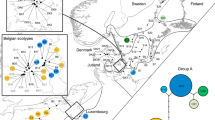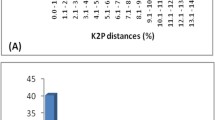Abstract
Phylogenetic associations among six closely related South American felid species were defined by changes in protein-encoding gene loci. We analyzed proteins isolated from skin fibroblasts using two-dimensional electrophoresis and allozymes extracted from blood cells. Genotypes were determined for multiple individuals of ocelot, margay, tigrina, Geoffroy's cat, kodkod, and pampas cat at 548 loci resolved by two-dimensional electrophoresis and 44 allozyme loci. Phenograms were constructed using the methods of Fitch-Margoliash and neighbor-joining on a matrix of Nei's unbiased genetic distances for all pairs of species. Results of a relative-rate test indicate changes in two-dimensional electrophoresis data are constant among all South American felids with respect to a hyena outgroup. Allelic frequencies were transformed to discrete character states for maximum parsimony analysis. Phylogenetic reconstruction indicates a major split occurred approximately 5–6 million years ago, leading to three groups within the ocelot lineage. The earliest divergence led to Leopardus tigrina, followed by a split between an ancestor of an unresolved trichotomy of three species (Oncifelis guigna, O. geoffroyi, and Lynchaduris colocolo) and a recent common ancestor of Leopardus pardalis and L. wiedii. The results suggest that modern South American felids are monophyletic and evolved rapidly after the formation of the Panama land bridge between North and South America.
Similar content being viewed by others
References
Adams EN III (1972) Consensus techniques and the comparison of taxonomic trees. Syst Zool 21:390–397
Avise JC, Aquadro CF (1981) A comparative summary of genetic distance in vertebrates. Evol Biol 14:114–126
Benveniste RE (1985) The contributions of retroviruses to the study of mammalian evolution. In: MacIntyre RJ (ed) Molecular evolutionary genetics. Plenum Press, New York, pp 359–417
Berta A (1983) A new species of small cat (Felidae) from the late Pliocene-early Pleistocene Uquian of Argentina. J Mammal 64: 720–725
Clutton-Brock J (1987) A natural history of domesticated animals. Cambridge University Press, Cambridge, England
Collier GE, O'Brien SJ (1985) A molecular phylogeny of the Felidae: immunological distance. Evolution 39:473–487
Dayhoff MO (1978) Survey of new data and computer methods of analysis. In: Dayhoff MO (ed) Atlas of protein sequence and structure, vol 5. Natl Biomed Res Found, Silver Springs, MD, pp 41–45
Ewer RF (1973) The carnivores. Cornell University Press, New York
Felsenstein J (1991) PHYLIP—phylogeny inference package (version 3.4). University of Washington, Seattle, WA
Ficcarelli G (1984) The Villafranchian cheetahs from Tuscany and remarks on the dispersal and evolution of the genus Acinonyx. Palaeontographia Italica 73:94–103
Glass GE, Martin LD (1978) A multivariate comparison of some extant and fossil Felidae, Carnivora. Carnivore 1:80–88
Goldman D, Giri PR, O'Brien SJ (1987) A molecular phylogeny of the hominoid primates as indicated by two-dimensional protein electrophoresis. Proc Natl Acad Sci USA 84:3307–3311
Goldman D, Giri PR, O'Brien SJ (1989) Molecular genetic-distance estimates among the Ursidae as indicated by one- and two-dimensional protein electrophoresis. Evolution 43:282–295
Goldman D, O'Brien SJ (1993) Two-dimensional protein electrophoresis in phylogenetic studies. In: Zimmer EA, White TJ, Cann RL, Wilson AC (eds) Molecular evolution: producing the biochemical data. Methods in enzymology, vol 224:113–121
Hemmer H (1978) The evolutionary systematics of living Felidae: present status and current problems. Carnivore 1:71–79
Janczewski DN (1992) Phylogenetic relationships of the great cats based on mitochondrial DNA sequence analysis. PhD dissertation, Graduate School of the University of Maryland, College Park, MD
Janczewski DN, Goldman D, O'Brien SJ (1990) Molecular divergence and variation of orangutan (Pongo pygmaeus) based on isozyme and two-dimensional electrophoresis. J Hered 81:375–387
Kurten B (1976) Fossil puma (Mammalia: Felidae) in North America. Neth J Zool 26:502–534
Kurten B (1968) Pleistocene mammals of Europe. Aldine, Chicago
Kurten B, Anderson E (1980) Pleistocene mammals of North America. Columbia University Press, New York
Leyhausen P (1979) Cat behavior. Garland Press, New York
Li W-H, Wu C-I, Luo C-C (1985) A new method for estimating synonymous and nonsynonymous rates of nucleotide substitution considering the relative likelihood of nucleotide and codon changes. Mol Biol Evol 2:150–174
McAlpine PJ, Shows TB, Miller RL, Pakstis AJ (1985) The 1985 catalog of mapped genes and report of the nomenclature committee. Eighth International Workshop on Human Gene Mapping. Cytogenet Cell Genet 40:8–66
Margush T, McMorris FR (1981) Consensus n-trees. Bull Math Biol 43:239–244
Martin LD (1989) Fossil history of the terrestrial Carnivora. In: Gittleman JL (ed) Carnivore behavior, ecology and evolution. Cornell University Press, Ithaca, NY
Menotti-Raymond M, O'Brien SJ (1993) Dating the genetic bottleneck of the African cheetah. Proc Natl Acad Sci USA 90:3172–3176
Millipore Corp (1991) Investigator 2 D electrophoresis system. Publication 17957.
Modi W, O'Brien SJ (1988) Quantitative cladistic analysis of chromosomal banding among species in three orders of mammals: hominoid primates, felids and arvicolid rodents. In: Gustafson JP, Appels R (eds) Chromosome structure and function. Plenum Press, New York, pp 215–242
Nei M (1978) Estimation of average heterozygosity and genetic distance from a small number of individuals. Genetics 89:583–590
Nei M (1987) Molecular evolutionary genetics. Columbia University Press, New York
Nei M, Stephens JC, Saitou N (1985) Methods for computing the standard errors of branching points in an evolutionary tree and their application to molecular data from humans and apes. Mol Biol Evol 2:66–85
Nowak RM (1991) Walker's Mammals of the world, 5th ed. Johns Hopkins University Press, Baltimore, MD
O'Brien SJ, Collier GE, Benveniste RE, Nash WG, Newman AK, Simonson JM, Eichelberger MA, Seal US, Bush M, Wildt DE (1987) Setting the molecular clock in the Felidae: the great cats, panthera. In: Tilson RL (ed) Tigers of the world. Noyes Publications, Park Ridge, NJ, pp 10–27
O'Brien SJ, Martenson IS, Eichelberger MA, Thorne ET, Wright FW (1989) Genetic variation and molecular systematics of the black-footed ferret. In: Seal US, Thorne ET, Bogan MA, Anderson SH (eds) Conservation biology and the black-footed ferret. Yale University Press, New Haven, pp 21–23
O'Brien SJ, Nash WG, Wildt DE, Bush M, Benveniste RE (1985) A molecular solution to the riddle of the giant panda's phylogeny. Nature 317:140–144
O'Brien SJ, Wildt DE, Goldman D, Merril CR, Bush M (1983) The cheetah is depauperate in genetic variation. Science 221:459–462
Pamilio P, Nei M (1988) Relationships between gene trees and species trees. Mol Biol Evol 5:568–583
Patterson B, Pascual R (1972) The fossil mammal fauna of South America. In: Keast A, Erk C, Glass B (eds) Evolution, mammals and southern continents. State University of New York Press, Albany, NY pp 247–309
Rogers JS (1984) Deriving phylogenetic trees from allele frequencies. Syst Zool 33:52–63
Savage DE, Russell DE (1983) Mammalian paleofaunas of the world. Addison-Wesley, London
Sokal RR, Rohlf FJ (1981) Taxonomic congruence in the Leptopodomorpha reexamined. Syst Zool 30:309–325
Swofford DL (1991) PAUP, phylogenetic analysis using parsimony, version 3.0. Illinois Natural History Survey, Champaign, IL
Swofford DL, Selander RK (1981) Biosys-1: a Fortran program for the comprehensive analysis of electrophoretic data in population genetics and systematics. J Hered 72:281–283
Turner A (1985) Extinction, speciation, and dispersal in African larger Carnivores from the late Miocene to recent. S Afr J Sci 81:256–257
Turner A (1987) New fossil carnivore remains from the Strekfontein hominid site (Mammalia: Carnivora). Ann Transvaal Museum 34:319–347
Van Valkenburgh B, Grady F, Kurten B (1990) The Plio-Pleistocene cheetah-like cat Miracinonyx inexpectatus of North America. J Vert Paleontol 10:434–454
Wayne RK, Benveniste RE, Janczewski DN, O'Brien SJ (1989) Molecular and biochemical evolution of the Carnivora. In Gittleman JL (ed) Carnivore behavior, ecology and evolution. Cornell University Press, Ithaca, NY, pp 465–494
Wayne RK, O'Brien SJ (1987) Allozyme divergence within the Canidae. Sys Zool 36:339–355
Wayne RK, Van Valkenburgh B, O'Brien SJ (1991) Molecular distance and divergence time in carnivores and primates. Mol Biol Evol 8:297–319
Werdelin L (1985) Small Pleistocene felines of North America. J Vert Paleontol 5:94–210
Wu C-I (1991) Inferences of species phylogeny in relation to segregation of ancient polymorphisms. Genetics 127:429–435
Wurster-Hill DH, Centerwall WR (1982) The interrelationships of chromosome banding pattern in canids, mustelids, hyena and felids. Cytogenet Cell Genet 34:178–192
Zuckerkandl E, Pauling L (1962) Molecular disease, evolution and genic heterogeneity. In Kasha M, Pullman B (eds) Horizons in biochemistry. Academic Press, NY, pp 189–225
Author information
Authors and Affiliations
Additional information
Correspondence to: J. Pecon Slattery
Rights and permissions
About this article
Cite this article
Pecon Slattery, J., Johnson, W., Goldman, D. et al. Phylogenetic reconstruction of South American felids defined by protein electrophoresis. J Mol Evol 39, 296–305 (1994). https://doi.org/10.1007/BF00160153
Received:
Revised:
Accepted:
Issue Date:
DOI: https://doi.org/10.1007/BF00160153




